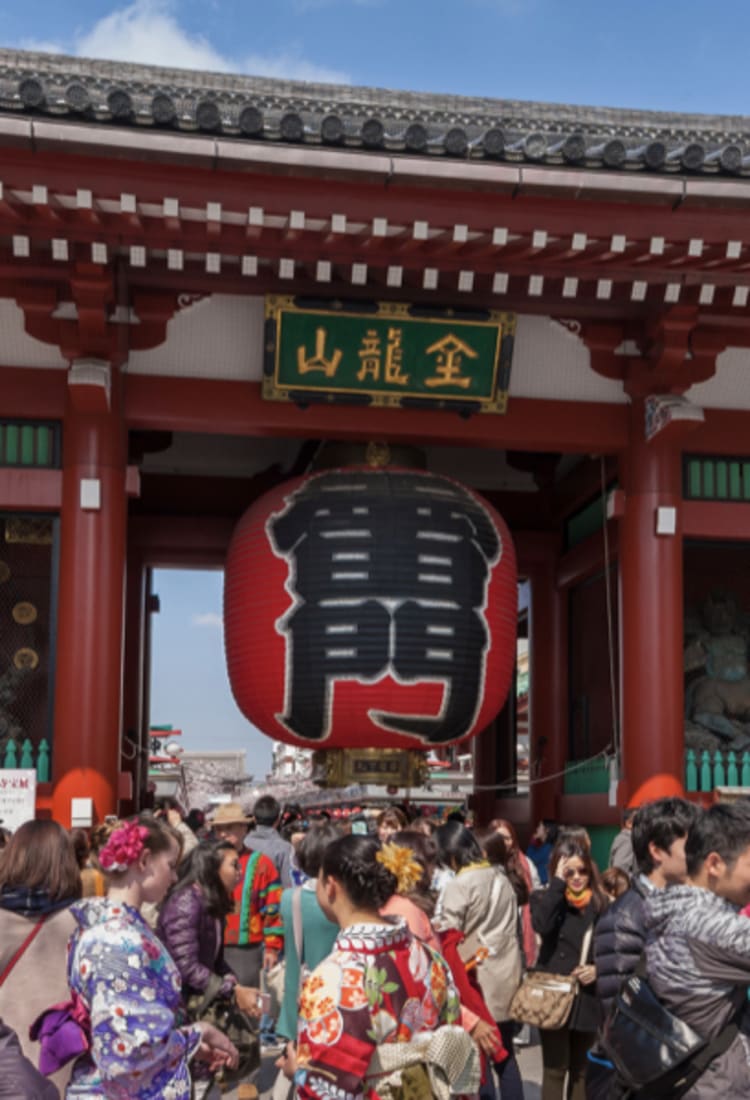
Spend the New Year in Tokyo, Mie, or Okinawa – Three journeys to pray for a year’s worth of happiness at shrines and temples or to greet the first sunrise
Spend the New Year in Tokyo, Mie, or Okinawa – Three journeys to pray for a year’s worth of happiness at shrines and temples or to greet the first sunrise
Hatsumode, or visiting shrines or temples to pray for the upcoming year, is the main event on New Year’s Day.

On January 1, it is a time-honored tradition in Japan to visit the local deity to give thanks for the blessings of the past year, and offer up prayers for happiness in the new one. This ritual is known as hatsumode. Shrines bustle with visitors turning their thoughts to the new year by recording their wishes on votive tablets, drawing omikuji sticks that tell fortunes for the coming year, and receiving charms or amulets aligned with their wishes. In recent years it isn’t only shrines that see lots of visitors, temples also attract large numbers of people.
When visiting a shrine, the first step before approaching the altar is to wash your hands and rinse your mouth at the purification trough. This signifies purifying your body before presenting yourself to the deity. Then, once you are standing at the altar, it is customary to throw coins into the offertory box (if any are present), as a sign of faithfulness to the deity. Two deep bows, followed by two claps and then a third deep bow is the basic worship ritual. And although there is no rigid dress code or other strict formalities, the shrine precinct is sacred ground and we ask visitors to please respect this.
Make a tour of the deities in Tokyo’s Asakusa and stock up on blessings as you stroll through the town

One of the Japanese New Year pleasures is the “Seven Gods of Good Fortune Pilgrimage,” where visitors make a tour of seven deities that bring good fortune as part of New Year’s Shinto shrine and Buddhist temple visits. The “Seven Gods of Good Fortune” are a group of deities who govern a range of different desires such as commercial prosperity, longevity, household peace and the like.
Tokyo’s Asakusa is home to a group of nine shrines and temples known as “Asakusa’s Seven Gods of Fortune Sites.” These shrines and temples, which include renowned Tokyo sightseeing spot Senso-ji, each enshrine one of the seven gods of fortune. You are welcome to start and finish your pilgrimage wherever you please.
– Daikokuten (God of wealth) – Senso-ji Temple
– Ebisu (God of bountiful fishing and good commerce) – Asakusa Jinja Shrine(English available)
– Bishamonten (God of riches and victory) – Matsuchiyama Shoden Temple(English available)
– Fukurokuju (God of abundant harvests) – Imado Jinja Shrine/Yasaki-Inari Jinja Shrine
– Hotei (God of prosperity) – Hashiba-Fudoson Temple (English available)
– Jurojin (God of longevity) – Ishihama Jinja Shrine/Otori Jinja Shrine(English available)
– Benzaiten (Goddess of music and water) – Yoshiwara Jinja Shrine
At Senso-ji Temple, close to Asakusa Station, visitors are welcomed by an outsized Japanese lantern suspended beneath the kaminarimon gate. Step through the gate and find yourself on a bustling 250 m store-lined path, known as “Nakamise,” that leads worshippers toward the temple’s main entrance. A statue of Daikokuten, one of the seven gods of good fortune, is enshrined in the Yogodo Hall.
If you are looking for love, Imado Jinja Shrine, dedicated to Fukurokuju, is known for blessing love matches. The enormous maneki neko*1 or beckoning cats in the main hall of the shrine also make a great photo opportunity.
Yoshiwara Jinja Shrine, dedicated to Benzaiten, is a shrine that once had a strong connection to Yoshiwara Yukaku,*2 the red-light district that was once located in the area. The women who worked in Yoshiwara Yukaku placed their faith in the shrine, and this has led to the shrine’s present-day reputation for granting women’s wishes.
Tracing the histories of the nine shrines and temples, and seeing how they connect to present day Asakusa is one of the charms of the journey.
*1 Maneki neko: Cat ornaments with a front paw raised to beckon people in. These cats are believed to be good luck charms for commercial prosperity.
*2 Yukaku: Regions housing brothels controlled and operated by the government.
At the nine shrines and temples that house Asakusa’s Seven Gods of Good Fortune you can obtain special items known as Juyohin, or worship gifts, to mark your pilgrimage. There are three items called fukuzasa (lucky bamboo grass), fukue (lucky pictures), and shikishi (seal collection boards). Take these with you as you tour the nine locations, and collect ema (votive tablets) or scarlet seals*3 to complete items such as the one shown in the photograph.
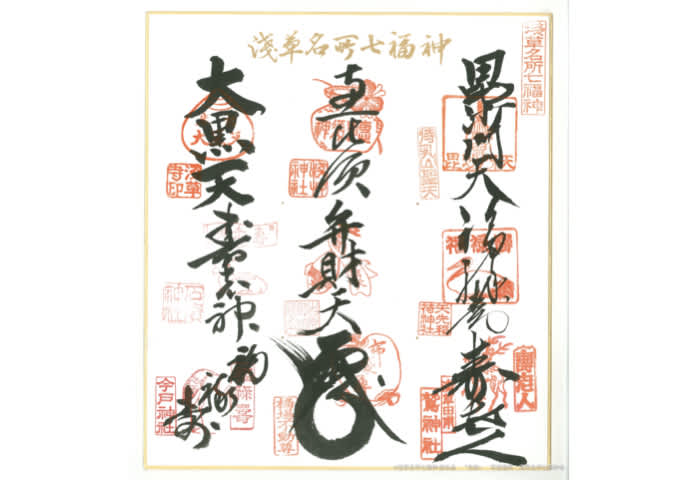
Walking the nine sites takes around four hours. If that’s too much, you can take one of the loop buses, the Megurin Sightseeing Bus or Panda Bus. Feel free to spread your visits over a number of days — that way you can be sure to see everything.
*3 Scarlet seals: A seal with the name of the shrine or temple in scarlet ink and the principal object of worship written in black ink that can be collected as a sign of having visited that particular site.
Also, if you want to experience the bustle that characterizes Tokyo’s New Year festivities, head over to Ueno’s Ameya-Yokocho widely known as Ameyoko. Visitors are greeted by mountains of goods and the voices of energetic vendors hawking the wares of the various different shops that line the streets of this market which is popular with locals and tourists alike. To get the full experience, try bargaining for discounts on souvenirs, or munching on fruit, kebabs, or taiyaki (fish shaped pancakes filled with sweet red bean paste) as you wander the streets.
Visit Ise Jingu and find yourself in the spiritual home of Japan

Located in Ise City in Mie Prefecture, Ise Jingu (English available), is officially named just Jingu, which simply means shrine — such is the iconic status of this revered shrine amongst other shrines in Japan. Since ancient times, many Japanese people have dreamed of making a pilgrimage to the sacred site of Ise at least once in their lifetime.
The name “Jingu” is a collective term that refers to the 125 shrines in the complexes, including the famous Naiku which enshrines Amaterasu-Omikami, the deity known as the ancestor of the royal family, and Geku which is dedicated to Toyo’uke-no-Omikami, guardian deity of industry, believed to provide cloth, food, and shelter.
To make your visit to Ise Jingu more authentic, follow ancient custom by starting at Geku first and then heading over to Naiku. These two shrines are separated by a distance of around 5 km, and most people travel by bus(English available) or taxi. When visiting Naiku and Geku, as with other shrines, it is customary to cleanse your mouth and hands at the purification trough before heading to the main palace.
Once you are there, be sure to take a moment to admire the unique architectural style known as yuiitsu shinmei-zukuri. The simple, linear design using raw Japanese cypress has a presence that evokes a sense of the divine.
Interestingly enough, these two main palaces, 14 of the subordinate shrines, and the Ujibashi Bridge at the Naiku entrance are all rebuilt every 20 years and a festival is held to commemorate the renewal. The festivities, known as “Shikinen-Sengu” are on a grand scale. Rich in history, they date back to the year 690. Held across a period of around eight years, the festival culminates in the rites to enshrine the deity in the new sanctuary, a ceremony known as Sengyo.
After visiting the shrines, drop by Oharai Machi, the small town bordering the gates to Naiku. It is home toOkage Yokocho (English available), an alley of picturesque souvenir shops and restaurants housed in traditional architecture from the Edo and Meiji Periods. Take a stroll along the alley, enjoying the New Year bustle.
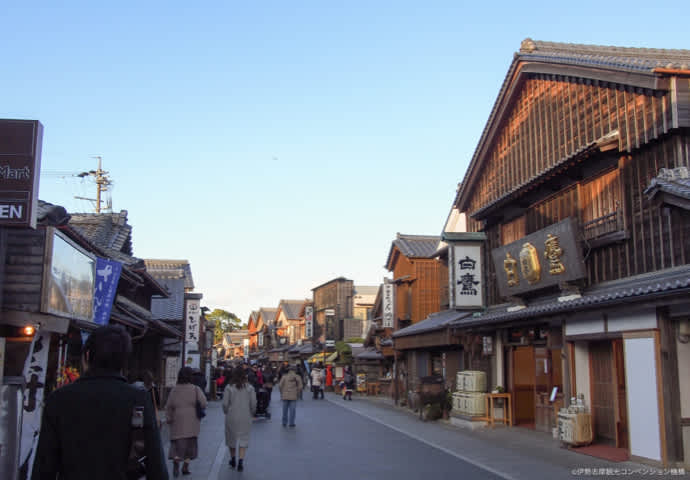
Watch a breathtaking sunrise on New Year’s Day from the tropical resort of Okinawa
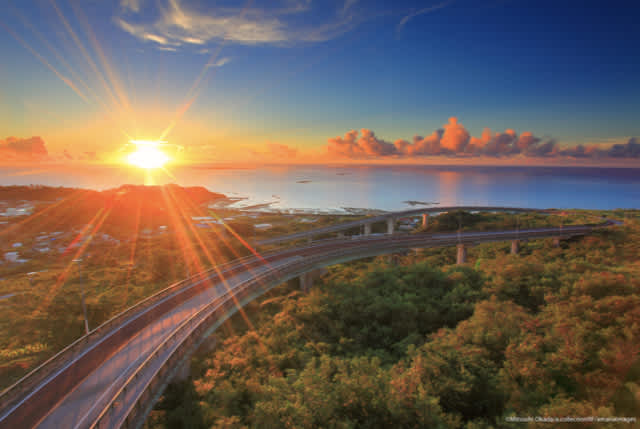
Gazing at the first sunrise of the new year and praying for the coming year’s happiness is one of Japan’s New Year traditions.
For a beautiful sunrise on the first day of the year, head to the tropical resort of Okinawa, where stunning ocean views are guaranteed, and you can enjoy New Year celebrations in relative warmth.
On Okinawa’s islands, the sun rises in the east-southeast at around 7:15 on January 1. Cape Chinen Park, found on Okinawa Main Island’s east coast, is located on a headland that offers 250-degree view of the surroundings, making it perfect for watching the first sunrise. The sun climbing up over the horizon creates a majestic scene and paints the beginning of the year in a glowing light.
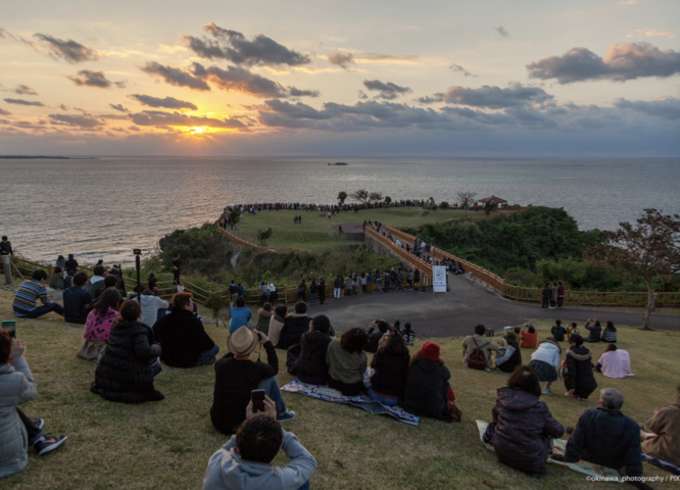
Nirai-Kanai Bridge is another spot that presents viewers with a marvelous prospect of the first sunrise of the year. View it from the observation platform that sits on top of the tunnel that is located near the highest point of the bridge. The unique twisting shape of the bridge juxtaposed with the ocean spread out in the distance and the sun illuminating the water creates an image of breathtaking beauty.
The drive takes about 45 minutes from downtown area of Naha City where the airport is located.
But you can greet the first sunrise from downtown Naha too. Shurijo Castle Park(English available), one of Naha’s most interesting sightseeing spots, is perched on a hill, and the first sunrise can be seen from the area outside the castle walls.
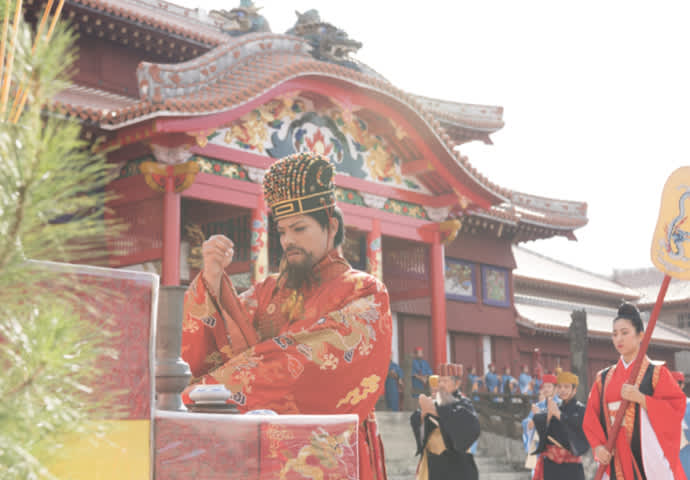
The annual Shinshun no Utage festival, held over the three days from January 1 to 3, gives visitors a chance to experience a range of special New Year cultural events from the Ryukyu Kingdom*4 era. All of these events are special, but Chohaiokishiki, a reenactment of the traditional New Year’s ceremony, is not to be missed.
The King and his officials marshal in the courtyard, praying to the gods of the heavens for peace and serenity in a ceremony that is solemn and majestic. Next, the officials swear fealty to the King, followed by rites to pray for the prosperity of the Ryukyu Kingdom, and then finally, cups of sake are passed around to everyone to complete the three-part ceremony to pray for the enduring prosperity of the King and his descendants.
After the ceremony, be sure to linger and enjoy Ryukyuan New Year events that can only be experienced at Shurijo Castle, including the brilliantly-costumed, sedate Ryukyuan dance, and the sweet amazake fermented rice drink given out to visitors.
*4 Ryukyu Kingdom: A kingdom centered around the Okinawa Islands that existed for the 450 years between 1429 and 1879.
For more information
– Tokyo Convention & Visitors Bureau
– Iseshima Tourism & Convention Organization
– Okinawa Convention & Visitors Bureau




















































